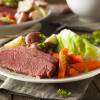When you watch Terry Ragasa at work, it’s clear that he is a master of his craft. Every month, a lucky few get an opportunity to learn from him as he wields the tools of his trade. His medium happens to be meat.
Two years ago, he and his wife, Susan Mygatt Ragasa, opened Sutter Meats in Northampton. (Sutter is a union of their first names.) It’s a neighborhood butcher shop that sources pork, lamb and beef from farms located within 30 miles of the store. The dozen or so producers with whom they work all adhere to standards and practices like pasture grazing that promote the health and well-being of their animals. These partnerships are win-win. Butcher shop customers get access to delicious, humanely raised meat, while the producers can sell their inventory much more quickly than if they marketed it themselves. “What we do helps grow sustainable practices on farms,” says Ragasa. “Our operating budget goes back into local farms in the community.”

Fostering community is a big part of what Sutter Meats does, even as the butcher shop redefines what it means to eat nose-to-tail. “We buy whole animals, and utilize everything,” says Ragasa, describing how even the smallest bits are transformed into value-added products like sausages, jerky and stock. “It’s important to use every scrap of meat since it once was a living being.”
The artisan and his team apply a technique called European seam butchery. Instead of relying on machine slicers, the approach involves finding the natural seams between muscles and separating them out with a boning knife. It’s a labor-intensive approach that results in several cuts unfamiliar to most. That’s where education is key. Teaching people about the more unusual portions was a big part of Ragasa’s apprenticeship at Fleisher’s Grass Fed & Organic Meats in New York’s Hudson Valley. He went on to develop the first whole-animal butchery program in Brooklyn before settling with Susan, also a trained butcher, in Western Massachusetts. The couple is keen on continuing the tradition at the shop.

Twice a month on a Saturday afternoon, Ragasa conducts a pork fabrication class, showing a small group of attendees how he utilizes seam butchery. On a recent weekend, six of us gather to watch as he unfastens the pig — split lengthwise from nose to tail — from a hook in a refrigerated chamber, hoists it on his shoulder, and lays the carcass on a butchering table. It lands with a thump. There’s no mistaking that this was a real animal—head, torso, legs and all. The Hereford-Tamworth cross was raised at Sage Farm in Montague and weighed over 200 pounds at live weight. For folks accustomed to grocery store meat, nestled on foam and encased in plastic, this is a fundamental lesson. Meat is no longer an abstract concept.

Over the next 2 hours, we observe Ragasa take apart the entire carcass. We touch the different cuts, feeling the textures of the various muscles and strips of fat. The tactile experience puts his cooking tips into context. Tougher, more worked muscles get a low-and-slow braise, while tender morsels need only a sear. Throughout the demonstration, staff butchers zip back and forth from the butchering table to the counter up front. In between, they help trim and triage meat from the demo pig. It’s a busy Saturday, and there are plenty of customers to serve. Susan has the couple’s 7 month-old daughter in tow, snuggled in a baby carrier while ringing up orders.
The only time Ragasa uses a hand saw is to separate the primal sections — the shoulder, loin and ham. Otherwise, he uses a 5 to 6-inch deboning knife to harvest specific muscles, following their natural separations, then carving them from bone if necessary. When knives are not in use, they rest in a scabbard (like a slender metal case) fastened with a chain around his waist. “I feel like a pirate or a knight,” he quips.

A specialty cut of meat you won’t see in a market or most other butcher shops is called the secreto. He liberates it so swiftly and efficiently that a follow-up explanation is in order. “It’s located on the top of the belly,” he says, “part of the flank that connects the hip back to the last rib, at the base of the loin section, below the inner skirt-steak. It’s hiding underneath a tougher cut of meat, and a layer of fat.” (Got that? It’s okay if you didn’t. It’s his job to know animal anatomy inside and out.) “You cook it like a beef skirt steak,” he continues. “Take salt and garlic and rub those into the grain. Do a 2-minute sear on each side, then cut it across the grain.”

Northampton resident Lindsay Koshgarian, one of the class attendees, is a convert to the secreto cut. She purchases a few of these meaty steaks to add to the take-home bag — full of country-style ribs, pork belly and sausages — included in the $100 class fee. As an avid home cook, she relies on the butchers at Sutter Meats for specialized cuts, and for advice on how to cook them. She likes having a direct connection with the butchers. “I never knew it was possible,” she says, referring to the relationships she has developed with staff. “It’s such a nice bonus.”
Koshgarian has been a fan of the store since it opened, and is thoughtful about the subject of meat. “I’m sort of a self-conscious meat eater,” Koshgarian shares. “I know meat production is not the greatest thing for the environment, and we’re asking animals to give up their lives for us. I’m exploring my own qualms even as I continue to eat meat. So a firsthand experience like this allows me to confront meat as having been an animal rather than something vacuum packed.”
When asked how she thinks others would respond if they attended a demo like this, she’s quick to comment. “I think anyone, if they had an experience like this, would think more about where their food comes from and take care of it.”
The Sutter Meats team should feel proud. All of that education is paying off.
Sutter Meats is located in Northampton at 65 King St., Visit
suttermeats.com
or call 413-727-3409 to sign up for an upcoming pork fabrication class.




